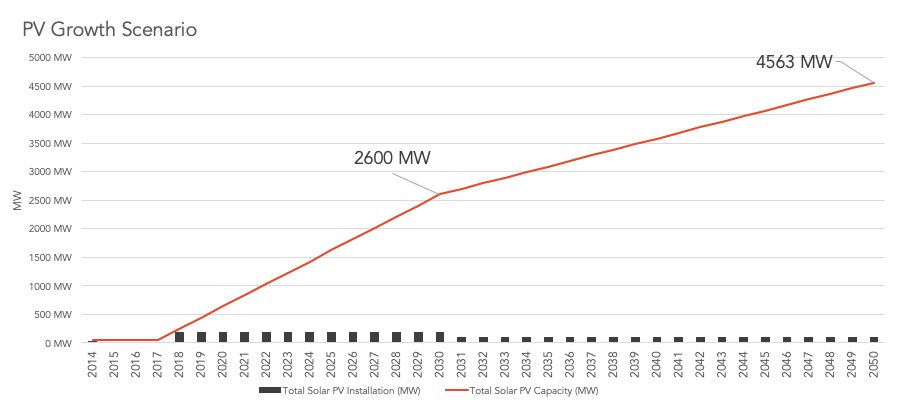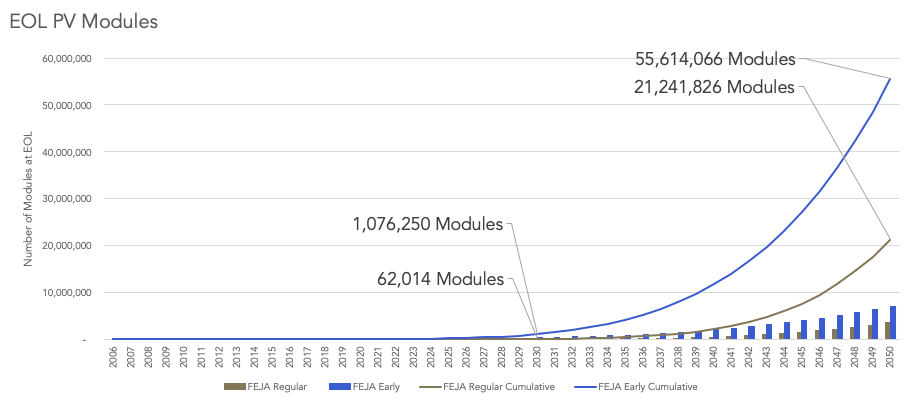Solar power is now the fastest-growing energy source in the world. As of the end of 2020, over 97 gigawatts (GW) of solar capacity have been installed in the U.S. [1] The International Renewable Energy Agency projects a substantial increase in solar modules reaching EoL as early in the 2020s and 2030s. [2]
In 2016, Illinois passed the Future Energy Jobs Act (FEJA). With the passage of FEJA, the state is required to significantly increase renewable energy capacity, including solar which is estimated to reach around 2,600 megawatts (MW) by 2030. This is an increase of over 2,500 MW from the 87 MW of solar capacity that was installed in the state when FEJA passed in 2016. Through this project, ISTC has found that:
- By the end of 2020, Illinois has installed approximately 465 MW of PV, equaling more than a million PV modules currently installed in the state [3].
- With FEJA’s 25% Renewable Energy Portfolio requirements, Illinois is expected to add an additional ~7 million PV modules by 2025, weighing an estimated 120 thousand Metric Tons based on current equipment and technology estimates.
- By 2030 Illinois will have between ~100 thousand to ~600 thousand modules reaching their end-of-life. This will result in an estimated 2,000 to 12,000 MT of material that that must be managed through recovery, recycling, & reuse or landfill disposal.
- In Illinois, ~2 million PV modules will reach EoL by 2050. This will result in an estimated 40,000 MT of material that must be managed.
- EoL PV module waste can include U.S. and Illinois Environmental Protection Agency regulated materials such as silver, copper, lead, arsenic, cadmium, and selenium. Depending on the size and volume of modules, they may be classified as regulated hazardous wastes.
- Recycling EoL PV modules can prevent toxic compounds from entering the environment and lead to the recovery of high-value materials such as indium, silver, tellurium, and copper.


Through FEJA, Illinois has emerged as a leading state for solar job growth, with nearly 48% growth since 2016. [4] Statewide reuse and recycling requirements would help to divert millions of EoL PV modules from landfills and strengthen job opportunities for a new and diverse workforce.
Building upon FEJA’s successes, in January 2020, Illinois Governor Pritzker and dozens of legislators have committed to a goal of 100% renewable energy by 2050. On March 15th, 2021 two bills passed the Energy and Environment Committee addressing 100% renewable energy legislation. Both of these bills will now move to the full Illinois House of Representatives for debate and a vote on the floor.
[1] Solar Energy Industries Association, U.S. Solar Market Insight Executive Summary 2020 Year in Review, 2021
[2] International Renewable Energy Agency & the International Energy Agency, Photovoltaic Power Systems End-of-Life Management: Solar Photovoltaic Panels, 2016
[3] Solar Energy Industries Association, Illinois Solar – Data Current Through: Q4 2020, 2021
[4] The Solar Foundation, Illinois Solar Job Census 2019, 2021

